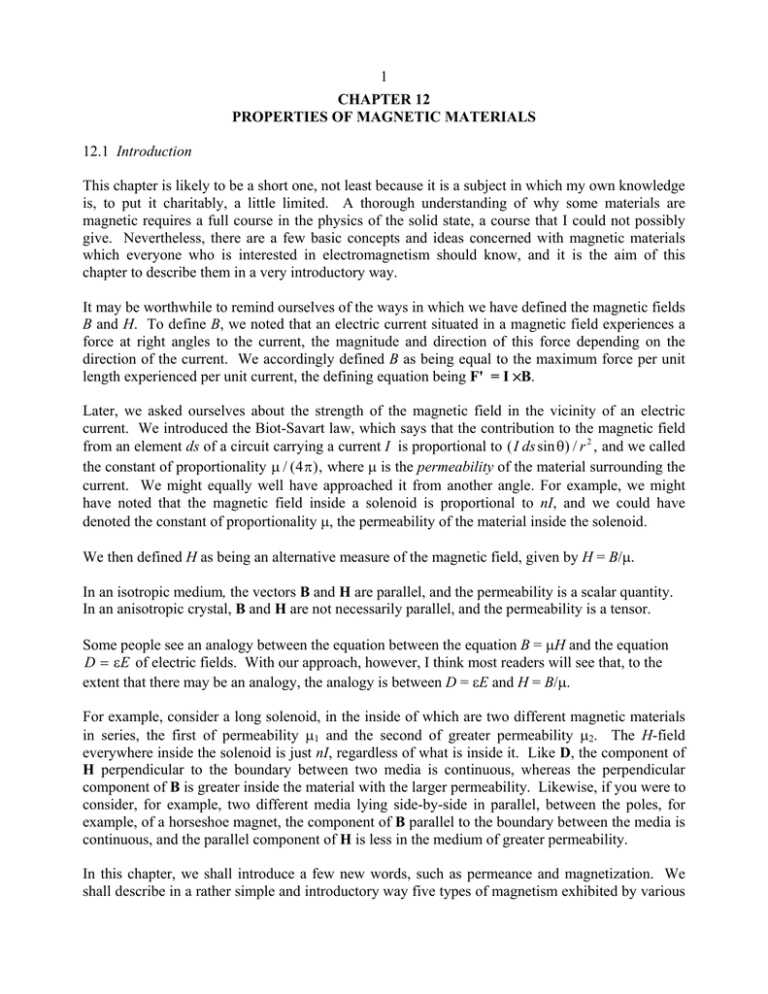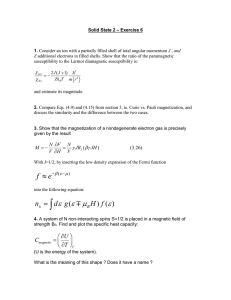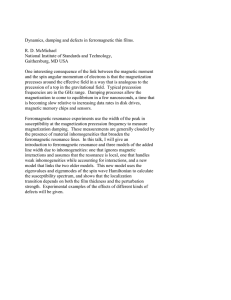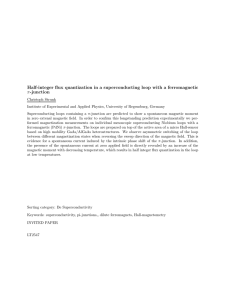1 CHAPTER 12 PROPERTIES OF MAGNETIC MATERIALS 12.1
advertisement

1 CHAPTER 12 PROPERTIES OF MAGNETIC MATERIALS 12.1 Introduction This chapter is likely to be a short one, not least because it is a subject in which my own knowledge is, to put it charitably, a little limited. A thorough understanding of why some materials are magnetic requires a full course in the physics of the solid state, a course that I could not possibly give. Nevertheless, there are a few basic concepts and ideas concerned with magnetic materials which everyone who is interested in electromagnetism should know, and it is the aim of this chapter to describe them in a very introductory way. It may be worthwhile to remind ourselves of the ways in which we have defined the magnetic fields B and H. To define B, we noted that an electric current situated in a magnetic field experiences a force at right angles to the current, the magnitude and direction of this force depending on the direction of the current. We accordingly defined B as being equal to the maximum force per unit length experienced per unit current, the defining equation being F' = I %B. Later, we asked ourselves about the strength of the magnetic field in the vicinity of an electric current. We introduced the Biot-Savart law, which says that the contribution to the magnetic field from an element ds of a circuit carrying a current I is proportional to ( I ds sin θ) / r 2 , and we called the constant of proportionality µ / ( 4 π ), where µ is the permeability of the material surrounding the current. We might equally well have approached it from another angle. For example, we might have noted that the magnetic field inside a solenoid is proportional to nI, and we could have denoted the constant of proportionality µ, the permeability of the material inside the solenoid. We then defined H as being an alternative measure of the magnetic field, given by H = B/µ. In an isotropic medium, the vectors B and H are parallel, and the permeability is a scalar quantity. In an anisotropic crystal, B and H are not necessarily parallel, and the permeability is a tensor. Some people see an analogy between the equation between the equation B = µH and the equation D = εE of electric fields. With our approach, however, I think most readers will see that, to the extent that there may be an analogy, the analogy is between D = εE and H = B/µ. For example, consider a long solenoid, in the inside of which are two different magnetic materials in series, the first of permeability µ1 and the second of greater permeability µ2. The H-field everywhere inside the solenoid is just nI, regardless of what is inside it. Like D, the component of H perpendicular to the boundary between two media is continuous, whereas the perpendicular component of B is greater inside the material with the larger permeability. Likewise, if you were to consider, for example, two different media lying side-by-side in parallel, between the poles, for example, of a horseshoe magnet, the component of B parallel to the boundary between the media is continuous, and the parallel component of H is less in the medium of greater permeability. In this chapter, we shall introduce a few new words, such as permeance and magnetization. We shall describe in a rather simple and introductory way five types of magnetism exhibited by various 2 materials: diamagnetism, paramagnetism, ferromagnetism, ferrimagnetism. And we shall discuss the phenomenon of hysteresis. antiferromagnetism and 12.2 Magnetic Circuits and Ohm's Law Some people find it helpful to see an analogy between a system of solenoids and various magnetic materials and a simple electrical circuit. They see it as a "magnetic circuit". I myself haven't found it to be particularly useful – but, as I mentioned, my experience in this field is less than extensive. I think it may be useful for some readers, however, at least to be introduced to the concept. The magnetic field inside a long solenoid is given by B = µnI = µNI / l . Here, n is the number of turns per unit length, N is the total number of turns, and l is the length of the solenoid. If the crosssectional area of the solenoid is A, the B-flux is Φ B = µNIA / l . This can be written NI = Φ B × l . µA 12.2.1 The analogy which some people find useful is between this and Ohm's law: V = I R. 12.2.2 The term NI, expressed in ampere-turns, is the magnetomotive force MMF. The symbol ΦB is the familiar B-flux, and is held to be analogous to current. The term l / ( µA) is the reluctance, expressed in H−1. Reluctances add in series. The reciprocal of the reluctance is the permeance, expressed in H. Permeances add in parallel. Although the SI unit of permeance is the henry, permeance is not the same as the inductance. It µAN 2 . will be recalled, for example, that the inductance of a long solenoid of N turns is l Continuing with the analogy, we recall that resistivity = (A / l) % resistance; Similarly reluctivity = (A / l) % reluctance = 1/µ. (m H−1) Also, the reciprocal of resistance is conductance. Similarly the reciprocal of reluctance is permeance. (H) And conductivity is (l / A) % conductance. Likewise (l / A) % permeance is – what else? – permeability µ. (H m−1) 3 I have mentioned these names partly for completeness and partly because it's fun to write some unusual and unfamiliar words such as permeance and reluctivity. I am probably not going to use these concepts further or give examples of their use. This is mostly because I am not as familiar with them myself as perhaps I ought to be, and I am sure that there are contexts in which these concepts are indeed highly useful. The next section introduces some more funny words, such as magnetization and susceptibility – but these are words that you will need to know and understand. 12.3 Magnetization and Susceptibility The H-field inside a long solenoid is nI. If there is a vacuum inside the solenoid, the B-field is µ 0 H = µ 0nI . If we now place an iron rod of permeability µ inside the solenoid, this doesn't change H, which remains nI . The B-field, however, is now B = µH . This is greater than µ0H, and we can write B = µ0 ( H + M ) . 12.3.1 The quantity M is called the magnetization of the material. In SI units it is expressed in A m−1. We see that there are two components to B. There is the µ 0 H = µ 0nI , which is the externally imposed field, and the component µ0M, originating as a result of something that has happened within the material. It might have occurred to you that you would have preferred to define the magnetization from B = µ0H + M, so that the magnetization would be the excess of B over µ0H. The equation B = µ0H + M, would be analogous to the familiar D = ε 0 E + P , and the magnetization would then be expressed in tesla rather than in A m−1 . This viewpoint does indeed have much to commend it, but so does B = µ 0 ( H + M ) . The latter is the recommended definition in the SI approach, and that is what we shall use here. The ratio of the magnetization M ("the result") to H ("the cause"), which is obviously a measure of how susceptible the material is to becoming magnetized, is called the magnetic susceptibility χm of the material: M = χm H . 12.3.2 On combining this with equation 12.3.1 and B = µH, we readily see that the magnetic susceptibility (which is dimensionless) is related to the relative permeability µ r = µ / µ 0 by µ r = 1 + χm . 12.3.3 4 12.4 Diamagnetism We mentioned in Section 12.1 that there are five types of magnetism exhibited by various materials. In this section we deal with the first of these, namely, diamagnetism. Diamagnetic materials have a very weak negative susceptibility, typically of order −10−6. That is to say, the relative permeability is slightly less than 1. Consequently, when a diamagnetic material is placed in a magnetic field, B < µ 0 H . If you are now hearing about this phenomenon for the first time, you may be a little surprised, and you will be expecting me to present a very short list of quite exotic materials known to be diamagnetic. So, here comes a further surprise: All materials are diamagnetic. Some materials may also be paramagnetic or ferromagnetic, and their positive paramagnetic or ferromagnetic susceptibilities may be larger than their negative diamagnetic susceptibility, so that their overall susceptibility is positive. But all materials are diamagnetic, even if their diamagnetism is hidden by their greater para- or ferromagnetism. A proper account of the mechanism at the atomic level of the cause of diamagnetism requires a quantum mechanical treatment, but we can understand the phenomenon qualitatively classically. We just have to think of an atom as being a nucleus surrounded by electrons moving in orbits around the nucleus. When an atom (or a large collection of atoms in a macroscopic sample of matter) is placed in a magnetic field, a current is induced within the atom by electromagnetic induction. That is, the electrons are caused to orbit around the nucleus, and hence to give the atom a magnetic moment, in such a direction as to oppose the increase in the magnetic field that causes it. The result of this happening to all of the atoms in a macroscopic sample is that B will now be less than µ0H, and the susceptibility will be negative. But, you may argue, these induced currents and their associated opposing magnetic moments will last only so long as the external field is changing. In fact it persists as long as the magnetizing field persists. The reason is as follows. In Chapter 10, we were dealing with wires and coils and resistors, and any current induced by a changing magnetic field was rapidly dissipated. For an electron in an orbit around a nucleus, however, there is no resistance, so, once it is set in motion, it will stay in motion. The same situation would arise if we were to induce a current in a loop of wire made of superconducting material whose resistance is zero. The current, once induced, continues, and is not dissipated away as heat. 12.5 Paramagnetism Diamagnetism makes itself evident in atoms and molecules that have no permanent magnetic moment. Some atoms or molecules, however, do have a permanent magnetic moment, and such materials are paramagnetic. They must still be diamagnetic, but often the paramagnetism will outweigh the diamagnetism. The magnetic moment of an atom of a molecule is typically if order of a Bohr magneton. (See Chapter VII, Sections 21-23, of Stellar Atmospheres for more details about the Bohr magneton and the magnetic moments of atoms. All that we need note here is that a Bohr magneton is about 9.3 % 10−24 N m T−1.) The presence of a permanent magnetic moment is often the result of unpaired electron spins. An example often quoted is the oxygen molecule O2. Liquid 5 oxygen indeed is paramagnetic. When a paramagnetic material is placed in a magnetic field, the magnetic moments experience a torque and they tend to orient themselves in the direction of the magnetic field, thus augmenting, rather than diminishing, B. Unsurprisingly the effect is greatest at low temperatures, where the random motion of atoms and molecules is low. At liquid helium temperatures (of order 1 K), susceptibilities can be of order +10−3 or +10−2, thus greatly exceeding the small negative susceptibility. At room temperature, paramagnetic susceptibilities are much less – typically about +10−5, barely exceeding the diamagnetic susceptibility. 12.6 Ferromagnetism What we normally think of as magnetic materials are technically ferromagnetic. The susceptibilities of ferromagnetic materials are typically of order +103 or 104 or even greater. However, the ferromagnetic susceptibility of a material is quite temperature sensitive, and, above a temperature known as the Curie temperature, the material ceases to become ferromagnetic, and it becomes merely paramagnetic. Among the elements, only cobalt, iron and nickel are strongly ferromagnetic, their Curie temperatures being about 1400, 1040 and 630 K respectively. Gadolinium is ferromagnetic at low temperatures; its Curie temperature is about 289 K = 16 oC. Dysprosium is ferromagnetic below its Curie temperature of about 105 K. There are many artificial alloys and ceramic materials which are ferromagnetic. As with paramagnetic materials, the atoms have permanent magnetic moments, but with the difference that these moments are not randomly oriented but are strongly aligned to the crystallographic axes. Within a single crystal, there exist domains, within which all the magnetic moments are parallel and are aligned with a particular axis. In an adjacent domain, again all the moments are parallel to each other, but they may be aligned with a different axis, perhaps at right angles to the first domain, or perhaps aligned with the same axis but pointing in the opposite direction. Thus we have a number of domains, each highly magnetized, but with some domains magnetized in one direction and some in another. The domains are separated by domain boundaries, or “Bloch walls”, perhaps a few hundred atoms thick, within which the orientation of the magnetic moments gradually changes from one domain to the next. Figure XII.1 is a schematic sketch of a crystal divided into four domains, with the magnetization in a different direction in each. FIGURE XII.1 6 In figure XIII.2 I am exposing the crystal to a progressively stronger and stronger magnetic field, and we watch what happens to the domains, and, in figure XIII.3, to the magnetization of the crystal as a whole. B B a b c FIGURE XII.2 M d FIGURE XII.3 b RM a CF c H When we first apply a weak field (a), the Bloch walls (domain boundaries) move so that the favorably-oriented domains grow at the expense of the opposing domains, and the magnetization 7 slowly increases. With stronger fields (b), suddenly all the magnetic moments (due to unpaired spins) within a single domain change direction almost in unison, so that an opposing domain suddenly becomes a favorable domain; this happens to one domain after another, until all domains are oriented favorably, and the magnetization of the specimen rapidly increases. For yet stronger fields (c), the magnetic moments, usually oriented parallel to a crystal axis, bend so that they are in the direction of the magnetizing field. When all of that is achieved, no further magnetization is possible, and the specimen is saturated. Now, if the field is reduced, the magnetic moments relax and take up their normal positions parallel to a crystallographic axis. But, as the field is further reduced (d), there is no reason for the domains to reverse their polarity as happened at stage (b). That is, when stage (b) originally happened, this was an irreversible process. The demagnetization curve does not follow the magnetization curve in reverse. Consequently, when the magnetizing field has been reduced to zero, the specimen retains a remanent magnetization (indicated by RM in figure XIII.3), with all domains still favorably oriented. In order to reduce the magnetization to zero, you have to apply a field in the reverse direction. The reverse field needed to reduce the magnetization to zero is called the coercive force (indicated by CF in figure XIII.3). As you repeatedly magnetize the specimen first on one direction and then the other, the graph of magnetization versus magnetizing field describes the hysteresis loop indicated in figure XII.3. Because of the irreversible process (b), magnetic energy is dissipated as heat during a complete cycle, the about of energy loss being proportional to the area of the hysteresis loop. The amount of the hysteresis depends on how freely the domain walls can move, which in turn depends on the physical and chemical constitution of the magnetic materials, particularly on the number of impurities present that can inhibit Bloch wall movement. For a permanent magnet, you need a material with a fat hysteresis loop, with a large remanent magnetization as well as a large coercive force, so that it cannot be demagnetized easily. For a transformer core, you need a material with a narrow hysteresis loop. If you put a magnetic material inside a solenoid with alternating current inside the solenoid, the magnetization will repeatedly go around the hysteresis loop. If you now gradually decrease the amplitude of the current in the solenoid, the hysteresis loop will gradually become smaller and smaller, vanishing to a point (H and M both zero) when the current is reduced to zero. This provides a method of demagnetizing a specimen. It is distressing how often one reads of the “remnant” magnetization. I have even encountered over-enthusiastic copyeditors who will change an author’s correct spelling “remanent” to the incorrect “remnant”. The difference is that “remnant” is a noun (as in a remnant of cloth) and “remanent”, which is pronounced with three distinct syllables, is an adjective, meaning “remaining”. 12.7 Antiferromagnetism I include this largely for completeness, but I am obliged to be brief, because it is a subject I know little about. It is my understanding that it involves materials in which the atoms or ions or molecules have a permanent dipole moment (resulting from unpaired electron spins), as in paramagnetic and ferromagnetic materials, and the crystals have domain structure, as in 8 ferromagnetic materials, but alternating ions within a domain have their magnetic moments oriented in opposite directions, so the domain as a whole has zero magnetization, or zero susceptibility. An example of an antiferromagnetic material is manganese oxide MnO, in which the Mn++ ion has a magnetic moment. Such materials are generally antiferromagnetic at low temperatures. As the temperature is increased, the domain structure breaks down and the material becomes paramagnetic – as also happens, of course, with ferromagnetic materials. But whereas the susceptibility of a ferromagnetic material decreases dramatically with rising temperature, until it become merely paramagnetic, the susceptibility of an antiferromagnetic material starts at zero, and its transformation to a paramagnetic material results in an increase (albeit a small increase) in its susceptibility. As the temperature is raised still further, the paramagnetic susceptibility drops (as is usual for paramagnetics), so there is presumably some temperature at which the susceptibility is a maximum. 12.8 Ferrimagnetism This section will be shorter still, because I know even less about it! It is my understanding that, like ferromagnetics and antiferromagnetics, there is a domain structure, and, like antiferromagnetics, alternate magnetic moments are pointing in opposite directions. But this does not result is complete cancellation of the magnetization of a domain. This often results if the alternating atoms or ions within a domain are different species, with unequal magnetic moments.




